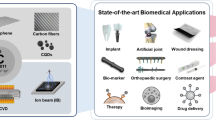Abstract
Recent interest in bio-inspired materials has led to the development of techniques that can be used to synthesize hierarchical structures with controlled morphology and mineralogy. One such technique investigated in this study consists of the use of electromigration and electrodeposition techniques to deposit mineral phases with controlled morphology and mineralogy by infilling a predefined porous templates. Here, the utility of precipitating various polymorphs of calcium carbonate in three-dimensional templates is demonstrated. Applied potentials and times were varied while scanning electron microscopy and X-ray diffraction were used to determine polymorph formed and its morphology. It was found that higher applied potentials and shorter operating times resulted in the formation of metastable polymorphs of calcium carbonate (e.g., vaterite) that infilled the porous media. Results provide insights for developing bio-inspired composite materials for various structural and medical applications, such as synthetic bone.











Similar content being viewed by others
References
Qiao L, Feng Q, Lu S (2008) In vitro growth of nacre-like tablet forming: from amorphous calcium carbonate, nanostacks to hexagonal tablets. American Chem Soc 8(5):1509–1514
Van der Biest O, Vandeperre L, Put S, Anne G, Vleugels J (2006) Laminated and functionally graded ceramics by electrophoretic deposition. Adv Sci Tech 45:1075–1084
Boccaccini AR, Keim S, Ma R, Li Y, Zhitomirsky I (2010) Electrophoretic deposition of bio-materials. J Roy Soc 7(5):581–613
Bersa L, Liu M (2007) A review on fundamentals and applicattions of electrophoretic deposition (EPD). Prog Mater Sci 52(1):1–61
Boccaccini AR, Zhitomirsky I (2002) Application of electrophoretic and electrolytic deposition techniques in ceramics processing. Curr Opin Solid State Mater Sci 6(3):251–260
Sarkar P, Nicholson P (1996) Electrophoretic deposition (EPD): mechanisms, kinetics and application to cereamics. J Am Ceram Soc 79(8):1987–2002
Van der Biest O, Vandeperre LJ (1999) Electrophoretic deposition of materials. Annu Rev Mater Res 29(1):327–352
Corni I, Ryan MP, Boccaccini AR (2008) Electrophoretic deposition: from traditional ceramics to nanotechnology. J Eur Ceram Soc 28(7):1353–1367
Morefield SW, Hock VF, Weiss CA, Malone PG Application of electrokinetic nanoparticle migration in the production of novel concrete-based composites. In: AIP Conf Proc, 2008. pp 266–271
Ma J, Wang C, Peng K (2003) Electrophoretic deposition of porous hydroxyapatite scaffolds. Biomater 24:3505–3510
Chen C-Y, Chen S-Y, Liu D-M (1999) Electrophoretic deposition forming of porous alumina membranes. Acta Mater 47(9):2717–2726
Barthelat F, Tang H, Zavattieri PD, Li C-M, Espinosa HD (2007) On the mechanics of mother-of-pearl: a key feature in the material hierarchical structure. J Mech Phys Sol 55(2):306–337
Allison PG, Rodriguez RI, Hodo WD, Kennedy AJ, Chandler MQ, Hidalgo RG, Moser RD, Peters JF Structure and mechanical properties of biological multi-layered material systems. In: Khan AS (ed) 18th International Symposium on Plasticity and its Current Applications, San Juan, PR, 2012. I. J. Plast., pp 199–201
Moser RD, Weiss Jr CA, Chandler MQ, Hodo WD, Malone PG, Chappell MA, Seiter JM, Lafferty B, Rodriguez RI, Negron OR, Torres-Cancel KA, Hidalgo-Hernandez RG Application of advanced characterization tools to the study of structural biomaterials and bio-inspired materials. In: 4th Int Symp Nanotechnol Const, 2012
Watanabe J, Akashi M (2008) Controlled deposition of calcium carbonate particles on porous membranes by using alternative current system. J Coll Int Sci 327(1):44–50
ASTM (2006) C642: Standard test method for density, absorption, and voids in hardened concrete
Fyfe WF, Bischoff JL The calcite-aragonite problem. In: SEPM Spec Pub, 1965. pp 3–13
MacInnes DA (1939) The principles of electrochemistry. Dover, New York
Tai CY, Chen FB (1998) Polymorphism of CaCO3 precipitated in a constant-composition environment. AIChE J 44(8):1790–1798
Weiss Jr CA, Moser RD, Malone P, Torres-Cancel K, Allison PG, Chandler MQ, Hidalgo RG (2012) Production of mixed carbonate phases using ammonium carbonate-metal acetate reactions. Bioinsp, Biomimet and Nanobiomater Accepted
Sawada K (1997) The mechanisms of crystallization and transformation of calcium carbonates. Pure Appl Chem 69(5):921–928
Park RJ, Meldrum FC (2004) Shape-constraint as a route to calcite single crystals with complex morphologies. J Mater Chem 14(14):2291–2296
Yanagishita H, Negishi H, Yokokawa H (2002) Electrophoretic deposition of solid oxide fuel cell material powders. In: Proc Electrochemical Soc on Electrophoretic Depos: Fundamentals and Applications, Pennington, NJ, USA, pp 214–221
Acknowledgments
The Authors would like to acknowledge the support for this work provided by the U.S. Army ERDC Center-Directed Research Program. The Authors would also like to thank the staff and facilities of the Geotechnical and Structures Laboratory’s Concrete and Materials Branch for supporting the experimental work. Permission to publish was granted by Director, Geotechnical and Structures Laboratory, U.S. Army Engineer Research and Development Center.
Author information
Authors and Affiliations
Corresponding author
Rights and permissions
About this article
Cite this article
Moser, R.D., Rodriguez, O.L., Hidalgo-Hernandez, R.G. et al. Infilling of porous materials with various polymorphs of calcium carbonate by an electromigration technique. J Appl Electrochem 43, 73–83 (2013). https://doi.org/10.1007/s10800-012-0501-6
Received:
Accepted:
Published:
Issue Date:
DOI: https://doi.org/10.1007/s10800-012-0501-6




